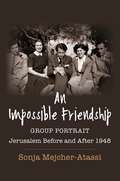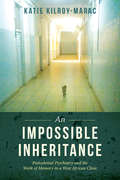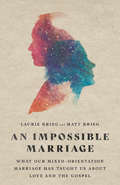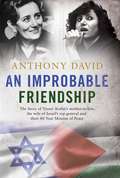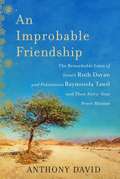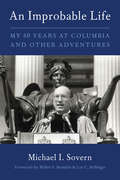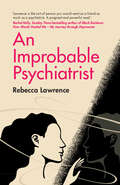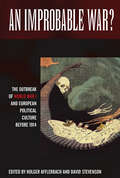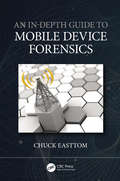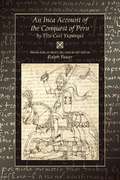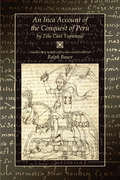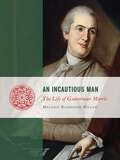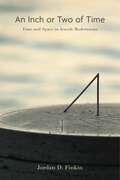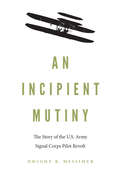- Table View
- List View
An Important Matter of Principle: The Decline of the Scottish Conservative and Unionist Party (Routledge Revivals)
by David SeawrightFirst published in 1999, this book examines the dramatic decline of the Conservative Party in Scotland. In 1955 the party secured over 50 per cent of the Scottish vote. At the last election it won a mere 17 per cent of the vote, losing its representation at Westminster in the process. But, until the publication of this work and despite its importance, relatively little was known about why the Conservative Party had declined so precipitously in Scotland. Many of the explanations for the party’s decline had largely remained untested. These included that the party had lost its Protestant base, suffered for its opposition to devolution and become too right wing for a normally progressive Scottish electorate. Using a unique collection of survey data, this work casts doubt on all three claims. Thus, this book makes a major academic contribution and examines, what for the Scottish Unionists, was An Important Matter of Principle.
An Impossible Dream: Reagan, Gorbachev, And A World Without The Bomb
by Guillaume SerinaThe riveting untold story behind the meeting between Ronald Reagan and Mikhail Gorbachev in Reykjavik to stop the nuclear arms race. When Ronald Reagan and Mikhail Gorbachev sat down in Reykjavik in 1986, George Shultz, the American secretary of state at the time, said that it was “the poker game with the highest stakes ever played.” It was the last time the world had a chance to do away entirely with nuclear weapons. This is the behind-the-scenes story of this remarkable summit conference in the remote Icelandic capital. An Impossible Dream is the first exploration of recently-available archives of both sides—top-secret archives of the Kremlin and the personal papers of Mikhail Gorbachev, as well as the archives of Ronald Reagan. These chronicles, personal diaries and previously classified memoranda are deeply enriched by the personal reminiscences of many of the key players at this era.But above all, the stage is set with a personal and exclusive preface from Mikhail Gorbachev himself. An Impossible Dream is the deeply important examination of the present and the future. The hazards of the nuclear age are legion, from aging weapons to new software that is vulnerable to terrorist attacks. With elements of the Trump administration considering a unilateral abrogation of the intermediate range nuclear missile (INF) treaty, the roots of which were laid at Reykjavik. Serina lays out this pivotal moment in history clearly and dramatically in this landmark work, as the world stands poised on the edge of a potential new arms race.
An Impossible Friendship: Group Portrait, Jerusalem Before and After 1948 (Religion, Culture, and Public Life #47)
by Sonja Mejcher-AtassiIn Jerusalem, as World War II was coming to an end, an extraordinary circle of friends began to meet at the bar of the King David Hotel. This group of aspiring artists, writers, and intellectuals—among them Wolfgang Hildesheimer, Jabra Ibrahim Jabra, Sally Kassab, Walid Khalidi, and Rasha Salam, some of whom would go on to become acclaimed authors, scholars, and critics—came together across religious lines in a fleeting moment of possibility within a troubled history. What brought these Muslim, Jewish, and Christian friends together, and what became of them in the aftermath of 1948, the year of the creation of the State of Israel and the Palestinian Nakba?Sonja Mejcher-Atassi tells the story of this unlikely friendship and in so doing offers an intimate cultural and social history of Palestine in the critical postwar period. She vividly reconstructs the vanished social world of these protagonists, tracing the connections between the specificity of individual lives and the larger contexts in which they are embedded. In exploring this ecumenical friendship and its artistic, literary, and intellectual legacies, Mejcher-Atassi demonstrates how social biography can provide a picture of the past that is at once more inclusive and more personal. This group portrait, she argues, allows us to glimpse alternative possibilities that exist within and alongside the fraught history of Israel/Palestine. Bringing a remarkable era to life through archival research and nuanced interdisciplinary scholarship, An Impossible Friendship unearths prospects for historical reconciliation, solidarity, and justice.
An Impossible Inheritance: Postcolonial Psychiatry and the Work of Memory in a West African Clinic
by Katie Kilroy-MaracWeaving sound historical research with rich ethnographic insight, An Impossible Inheritance tells the story of the emergence, disavowal, and afterlife of a distinctive project in transcultural psychiatry initiated at the Fann Psychiatric Clinic in Dakar, Senegal during the 1960s and 1970s. Today’s clinic remains haunted by its past and Katie Kilroy-Marac brilliantly examines the complex forms of memory work undertaken by its affiliates over a sixty year period. Through stories such as that of the the ghost said to roam the clinic’s halls, the mysterious death of a young doctor sometimes attributed to witchcraft, and the spirit possession ceremonies that may have taken place in Fann’s courtyard, Kilroy-Marac argues that memory work is always an act of the imagination and a moral practice with unexpected temporal, affective, and political dimensions. By exploring how accounts about the Fann Psychiatric Clinic and its past speak to larger narratives of postcolonial and neoliberal transformation, An Impossible Inheritance examines the complex relationship between memory, history, and power within the institution and beyond.
An Impossible Marriage: What Our Mixed-Orientation Marriage Has Taught Us About Love and the Gospel
by Laurie Krieg Matt Krieg"People say our marriage is impossible." Laurie and Matt Krieg are in a mixed-orientation marriage: a marriage in which at least one partner's primary attraction isn't toward the gender of their spouse. In the Kriegs' case, Laurie is primarily attracted to women—and so is Matt. Some find the idea of mixed-orientation marriage bewildering or even offensive. But as the Kriegs have learned, nothing is impossible with God—and that's as true of their marriage as anyone else's. In An Impossible Marriage, the Kriegs tell their story: how they met and got married, the challenges and breakthroughs of their journey, and what they've learned about marriage along the way. Christianity teaches us that marriage is a picture of Jesus’ love for the church—and that's just as true in a mixed-orientation marriage as in a straight one. With vulnerability and wisdom, this book lays out an engaging picture of marriage in all its pain and beauty. It's a picture that points us, over and over again, to the love and grace of Jesus—as marriage was always meant to do.
An Impossible Race? (Fountas & Pinnell Classroom, Guided Reading)
by Casey MaoNIMAC-sourced textbook. The Underdog. An old, slow farmer races against ten younger, faster runners. No one thinks the farmer has a chance … but they don't know about his secret weapon.
An Improbable Friendship
by Anthony DavidAn Improbable Friendship is the dual biography of Israeli Ruth Dayan, now ninety-seven, who was Moshe Dayan's wife for thirty-seven years, and Palestinian journalist Raymonda Tawil, Yasser Arafat's mother-in-law, now seventy-four. It reveals for the first time the two women's surprising and secret forty-year friendship and delivers the story of their extraordinary and turbulent lives growing up in a war-torn country. Based on personal interviews, diaries, and journals drawn from both women-Ruth lives today in Tel Aviv, Raymonda in Malta-author Anthony David delivers a fast-paced, fascinating narrative that is a beautiful story of reconciliation and hope in a climate of endless conflict. By telling their stories and following their budding relationship, which began after the Six-Day War in 1967, we learn the behind-the-scenes, undisclosed history of the Middle East's most influential leaders from two prominent women on either side of the ongoing conflict. An award-winning biographer and historian, Anthony David brings us the story of unexpected friendship while he discovers the true pasts of two outstanding women. Their story gives voice to Israelis and Palestinians caught in the Middle East conflict and holds a persistent faith in a future of peace.
An Improbable Friendship: The Remarkable Lives of Israeli Ruth Dayan and Palestinian Raymonda Tawil and Their Forty-Year Peace Mission
by Anthony DavidAn Improbable Friendship is the dual biography of Israeli Ruth Dayan, now ninety-eight, who was Moshe Dayan's wife for thirty-seven years, and Palestinian journalist Raymonda Tawil, Yasser Arafat's mother-in-law, now seventy-four. It reveals for the first time the two women's surprising and secret forty-year friendship and delivers the story of their extraordinary and turbulent lives growing up in a war-torn country. Based on personal interviews, diaries, and journals drawn from both women--Ruth lives today in Tel Aviv, Raymonda in Malta--author Anthony David delivers a fast-paced, fascinating narrative that is a beautiful story of reconciliation and hope in a climate of endless conflict. By experiencing their stories and following their budding relationship, which began after the Six-Day War in 1967, we learn the behind-the-scenes, undisclosed history of the Middle East's most influential leaders from two prominent women on either side of the ongoing conflict. An award-winning biographer and historian, Anthony David brings us the story of unexpected friendship while he discovers the true pasts of two outstanding women. Their story gives voice to Israelis and Palestinians caught in the Middle East conflict and holds a persistent faith in a future of peace.
An Improbable Journey
by Charles G. LubarAn insider&’s view on blockbuster deal-making and part cultural tour de force, An Improbable Journey is a one-of-a-kind, deeply textured account of how some of the greatest artists of all time pushed to realize their greatest ambitions—with the help of Charles Lubar.The year was 1971. Thirty-year-old Charles Lubar, a Washington, D.C.–born Harvard Law School graduate with a two-and-a-half-year deep dive in the Chief Counsel&’s Office of the Internal Revenue Service recently behind him, was floundering in Nairobi, Kenya where he had come to seek the kind of high-stakes adventures one could never find at a major law firm in the U.S. But with his entrepreneurial hopes quashed in Nairobi by an environment that hardly wrapped its arms around outsiders, Indians being expelled from Kenya, and Idi Amin—the ruthless despot—on the brink of taking over in neighboring Uganda and soon to wreak havoc throughout the region, Lubar decided to pick up his stakes. With a sense of timing that would come to his aid again and again throughout his life, the young lawyer opted to make his next home in the UK. Little did he know that he would soon be swimming hard and fast in 1970s London during a cultural surge of film, television, music, and the stage. &“Hired off the street&” by two American lawyers in London—the brassy entertainment lawyer Irwin Margulies and the corporate transactional lawyer Barry Sterling—Lubar could never have predicted that his work would soon put him front and center at some of the biggest moments with some of the biggest names in showbiz. From the James Bond franchise to Linda Lovelace and &“Deep Throat&”; from Jim Henson and The Muppets to Michael Jackson and the Beatles; from behind the Iron Curtain to the islands of the Netherlands Antilles, Lubar&’s rare knowledge of the tax codes spanning Europe and the U.S. made him an indispensable figure to creatives trying to make their financial lives work on both sides of the Atlantic. His list of clients goes on and on: Bill Graham, John Cleese, Santana, Diana Ross, Frank Oz, Chuck Traynor, Marilyn Chambers, Barbara Bach, Jane Seymour, Shakira, and Enrique Iglesias. Many turned to Lubar in real need of his assistance at the very prime (and sometimes, nadir) of their careers. Lubar&’s bona fides would even land him a spot on the US-UK Fulbright Commission, as President of the Yale Club of London, and a Managing Partner in London of one of the major international law firms. An Improbable Journey shows a risk-taker with his finger living right on the cultural pulse of a moment.
An Improbable Life
by Walter F. Mondale Lee C Bollinger Michael I. SovernColumbia University began the second half of the twentieth century in decline, bottoming out with the student riots of 1968. Yet by the close of the century, the institution had regained its stature as one of the greatest universities in the world.According to the New York Times, "If any one person is responsible for Columbia's recovery, it is surely Michael Sovern." In this memoir, Sovern, who served as the university's president from 1980 to 1993, recounts his sixty-year involvement with the institution, as well as his experiences growing up poor in the South Bronx and attending Columbia. Sovern addresses key debates in academia, such as how to make college available to all, whether affirmative action is fair, whether great researchers are paid too much and valuable teachers too little, what are the strengths and weaknesses of lifetime tenure, and what is the government's responsibility for funding universities. A labor-law specialist, Sovern also discusses his personal and professional accomplishments off campus, particularly his work to compensate victims of racial exploitation and his recommendations as chairman of the Commission on Integrity in Government.
An Improbable Life: My Sixty Years at Columbia and Other Adventures
by Michael I. SovernColumbia University began the second half of the twentieth century in decline, bottoming out with the student riots of 1968. Yet by the close of the century, the institution had regained its stature as one of the greatest universities in the world.According to the New York Times, "If any one person is responsible for Columbia's recovery, it is surely Michael Sovern." In this memoir, Sovern, who served as the university's president from 1980 to 1993, recounts his sixty-year involvement with the institution after growing up in the South Bronx. He addresses key issues in academia, such as affordability, affirmative action, the relative rewards of teaching and research, lifetime tenure, and the role of government funding. Sovern also reports on his many off-campus adventures, including helping the victims of the Tuskegee syphilis experiment, stepping into the chairmanship of Sotheby's, responding to a strike by New York City's firemen, a police riot and threats to shut down the city's transit system, playing a role in the theater world as president of the Shubert Foundation, and chairing the Commission on Integrity in Government.
An Improbable Life: The Autobiography
by Trevor McDonaldSir Trevor McDonald is an extraordinary man - and he has led an improbable life. Now in his 80th year, he is known and loved by people the world over for his humility, charm and natural ease. As a natural storyteller and communicator, he has few equals. In An Improbable Life, Sir Trevor recounts his personal experience of world events and interviews with globally famous - or notorious - figures. He has witnessed war and death and risked his own life to meet and talk with despots and liberators. We read about his first trip to South Africa, and obtaining the first British television interview with Nelson Mandela; his reflections on the Windrush generation; and experiencing Barack Obama's momentous inauguration as President of the USA. We are also present at his dramatic meetings with Saddam Hussein (the first and only one by a British television correspondent) and Muammar Gaddafi.Engaging, intimate and moving, this is the life story of an exceptional journalist and broadcaster who over decades has expertly revealed to us history in the making.
An Improbable Psychiatrist
by Rebecca LawrenceAn Improbable Psychiatrist is a powerful and insightful story of mental illness, told through the dual lens of a doctor, who later became a patient. Rebecca Lawrence shares her story of being a doctor and a psychiatrist while living with bipolar disorder. She details her experience of being an inpatient on a psychiatric ward, receiving electroconvulsive therapy, training as a doctor, and navigating the challenges of grief, loss, and family. Through her inspiring story, Rebecca aims to reduce the stigma surrounding mental illness and provide comfort to those who suffer from severe mood disorders and those who care for them. Told through engaging and captivating prose, this book will pull you into Rebecca's world and leave you with the powerful reminder that with the right support and treatment, it is possible to live with severe mental illness. Ultimately, this is a story of hope.
An Improbable War?
by David Stevenson Holger AfflerbachThe First World War has been described as the "primordial catastrophe of the twentieth century." Arguably, Italian Fascism, German National Socialism and Soviet Leninism and Stalinism would not have emerged without the cultural and political shock of World War I. The question why this catastrophe happened therefore preoccupies historians to this day. The focus of this volume is not on the consequences, but rather on the connection between the Great War and the long 19th century, the short- and long-term causes of World War I. This approach results in the questioning of many received ideas about the war's causes, especially the notion of "inevitability."
An Improper Profession: Women, Gender, and Journalism in Late Imperial Russia
by Barbara T. Norton Jehanne M. GheithJournalism has long been a major factor in defining the opinions of Russia's literate classes. Although women participated in nearly every aspect of the journalistic process during the nineteenth and early twentieth centuries, female editors, publishers, and writers have been consistently omitted from the history of journalism in Imperial Russia. An Improper Profession offers a more complete and accurate picture of this history by examining the work of these under-appreciated professionals and showing how their involvement helped to formulate public opinion. In this collection, contributors explore how early women journalists contributed to changing cultural understandings of women's roles, as well as how class and gender politics meshed in the work of particular individuals. They also examine how female journalists adapted to--or challenged--censorship as political structures in Russia shifted. Over the course of this volume, contributors discuss the attitudes of female Russian journalists toward socialism, Russian nationalism, anti-Semitism, women's rights, and suffrage. Covering the period from the early 1800s to 1917, this collection includes essays that draw from archival as well as published materials and that range from biography to literary and historical analysis of journalistic diaries. By disrupting conventional ideas about journalism and gender in late Imperial Russia, An Improper Profession should be of vital interest to scholars of women's history, journalism, and Russian history. Contributors. Linda Harriet Edmondson, June Pachuta Farris, Jehanne M Gheith, Adele Lindenmeyr, Carolyn Marks, Barbara T. Norton, Miranda Beaven Remnek, Christine Ruane, Rochelle Ruthchild, Mary Zirin
An Impulse and Earthquake Energy Balance Approach in Nonlinear Structural Dynamics
by Izuru Takewaki Kotaro KojimaProblems in nonlinear structural dynamics and critical excitation with elastic-plastic structures are typically addressed using time-history response analysis, which requires multiple repetitions and advanced computing. This alternative approach transforms ground motion into impulses and takes an energy balance approach. This book is accessible to undergraduates, being based on the energy balance law and the concepts of kinetic and strain energies, and it can be used by practitioners for building and structural design. This presentation starts with simple models that explain the essential features and extends in a step-by-step manner to more complicated models and phenomena.
An In-Depth Guide to Mobile Device Forensics
by Chuck EasttomMobile devices are ubiquitous; therefore, mobile device forensics is absolutely critical. Whether for civil or criminal investigations, being able to extract evidence from a mobile device is essential. This book covers the technical details of mobile devices and transmissions, as well as forensic methods for extracting evidence. There are books on specific issues like Android forensics or iOS forensics, but there is not currently a book that covers all the topics covered in this book. Furthermore, it is such a critical skill that mobile device forensics is the most common topic the Author is asked to teach to law enforcement. This is a niche that is not being adequately filled with current titles. An In-Depth Guide to Mobile Device Forensics is aimed towards undergraduates and graduate students studying cybersecurity or digital forensics. It covers both technical and legal issues, and includes exercises, tests/quizzes, case studies, and slides to aid comprehension.
An Inca Account of the Conquest of Peru
by Ralph BauerAvailable in English for the first time, An Inca Account of the Conquest of Peru is a firsthand account of the Spanish invasion, narrated in 1570 by Diego de Castro Titu Cusi Yupanqui - the penultimate ruler of the Inca dynasty - to a Spanish missionary and transcribed by a mestizo assistant. The resulting hybrid document offers an Inca perspective on the Spanish conquest of Peru, filtered through the monk and his scribe. Titu Cusi tells of his father's maltreatment at the hands of the conquerors; his father's ensuing military campaigns, withdrawal, and murder; and his own succession as ruler. Although he continued to resist Spanish attempts at "pacification," Titu Cusi entertained Spanish missionaries, converted to Christianity, and then, most importantly, narrated his story of the conquest to enlighten Emperor Phillip II about the behavior of the emperor's subjects in Peru. This vivid narrative illuminates the Incan view of the Spanish invaders and offers an important account of indigenous resistance, accommodation, change, and survival in the face of the European conquest. Informed by literary, historical, and anthropological scholarship, Bauer's introduction points out the hybrid elements of Titu Cusi's account, revealing how it merges native Andean and Spanish rhetorical and cultural practices. This new English edition will interest students of colonial Latin American history and culture and of Native American literatures.
An Inca Account of the Conquest of Peru
by Titu Cusi YupanquiAvailable in English for the first time, An Inca Account of the Conquest of Peru is a firsthand account of the Spanish invasion, narrated in 1570 by Diego de Castro Titu Cusi Yupanqui - the penultimate ruler of the Inca dynasty - to a Spanish missionary and transcribed by a mestizo assistant. The resulting hybrid document offers an Inca perspective on the Spanish conquest of Peru, filtered through the monk and his scribe. Titu Cusi tells of his father's maltreatment at the hands of the conquerors; his father's ensuing military campaigns, withdrawal, and murder; and his own succession as ruler. Although he continued to resist Spanish attempts at "pacification," Titu Cusi entertained Spanish missionaries, converted to Christianity, and then, most importantly, narrated his story of the conquest to enlighten Emperor Phillip II about the behavior of the emperor's subjects in Peru. This vivid narrative illuminates the Incan view of the Spanish invaders and offers an important account of indigenous resistance, accommodation, change, and survival in the face of the European conquest. Informed by literary, historical, and anthropological scholarship, Bauer's introduction points out the hybrid elements of Titu Cusi's account, revealing how it merges native Andean and Spanish rhetorical and cultural practices. Supported in part by the Colorado Endowment for the Humanities.
An Incarnational Model of the Eucharist (Current Issues In Theology #10)
by James M. ArcadiThe Eucharist is at the heart of Christian worship, and at the heart of the Eucharist are the curious phrases, ‘This is my body’ and ‘This is my blood’. James M. Arcadi offers a constructive proposal for understanding Christ’s presence in the Eucharist that draws on contemporary conceptual resources and is faithful to the history of interpretation. He locates his proposal along a spectrum of Eucharistic theories. Arcadi explores the motif of God’s presence related to divine omnipresence and special presence in holy places, which undergirds a biblical–theological proposal concerning Christ’s presence. Utilizing recent work in speech-act theory, Arcadi probes the acts of consecration and renaming in their biblical and liturgical contexts. A thorough examination of recent work in Christology leads to an action model of the Incarnation that borrows the notion of enabling externalism from philosophy of mind. These threads undergird an impanation model of Christ’s presence in the Eucharist.
An Incautious Man: The Life of Gouveneur Morris (Lives of the Founders)
by Melanie MillerIn An Incautious Man, historian Melanie Miller provides a succinct but sophisticated recounting of the life of one of our lesser-known but most engaging Founding Fathers: Gouverneur Morris.One of George Washington's "surrogate sons," Morris played a profound role in ensuring the success of the American Revolution and the creation of the Constitution. Miller provides readers a look behind the closed doors of the Constitutional Convention, where Morris's crystalline but passionate eloquence gave the debate a vitality that remains both enthralling and keenly meaningful for those of us whose lives have been decisively shaped by the results of that deliberation. In 1792, Morris replaced Thomas Jefferson as the American minister to France. His experience there during the Terror is unparalleled in diplomatic history. As Miller tells it, Morris's time in France is a story of conspiracy to help the king escape, of friends imprisoned and murdered, of seized ships and complex problems that had no precedent in the young nation's history. Upon his return to the U.S., Morris served a brief stint in the Senate before going on to secure the building of the Erie Canal and to direct the design of the Manhattan network of streets we know today.
An Incentive Approach to Identifying Financial System Vulnerabilities
by R. Barry Johnston Jingqing ChaiA report from the International Monetary Fund.
An Inch or Two of Time: Time and Space in Jewish Modernisms (Dimyonot)
by Jordan D. FinkinIn literary modernism, time and space are sometimes transformed from organizational categories into aesthetic objects, a transformation that can open dramatic metaphorical and creative possibilities. In An Inch or Two of Time, Jordan Finkin shows how Jewish modernists of the early twentieth century had a distinct perspective on this innovative metaphorical vocabulary. As members of a national-ethnic-religious community long denied the rights and privileges of self-determination, with a dramatically internalized sense of exile and landlessness, the Jewish writers at the core of this investigation reimagined their spatial and temporal orientation and embeddedness. They set as the fulcrum of their imagery the metaphorical power of time and space. Where non-Jewish writers might tend to view space as a given—an element of their own sense of belonging to a nation at home in a given territory—the Jewish writers discussed here spatialized time: they created an as-if space out of time, out of history. They understood their writing to function as a kind of organ of perception on its own. Jewish literature thus presents a particularly dynamic system for working out the implications of that understanding, and as such, this book argues, it is an indispensable part of the modern library.
An Inch or Two of Time: Time and Space in Jewish Modernisms (Dimyonot: Jews and the Cultural Imagination #3)
by Jordan D. FinkinIn literary modernism, time and space are sometimes transformed from organizational categories into aesthetic objects, a transformation that can open dramatic metaphorical and creative possibilities. In An Inch or Two of Time, Jordan Finkin shows how Jewish modernists of the early twentieth century had a distinct perspective on this innovative metaphorical vocabulary. As members of a national-ethnic-religious community long denied the rights and privileges of self-determination, with a dramatically internalized sense of exile and landlessness, the Jewish writers at the core of this investigation reimagined their spatial and temporal orientation and embeddedness. They set as the fulcrum of their imagery the metaphorical power of time and space. Where non-Jewish writers might tend to view space as a given—an element of their own sense of belonging to a nation at home in a given territory—the Jewish writers discussed here spatialized time: they created an as-if space out of time, out of history. They understood their writing to function as a kind of organ of perception on its own. Jewish literature thus presents a particularly dynamic system for working out the implications of that understanding, and as such, this book argues, it is an indispensable part of the modern library.
An Incipient Mutiny: The Story of the U.S. Army Signal Corps Pilot Revolt
by Dwight R. MessimerAn Incipient Mutiny traces the creation of the U.S. Army Signal Corps Aeronautical Division in 1907 up to the establishment of the Air Service of the National Army in 1918. It is a shocking account of shortsightedness, mismanagement, criminal fraud, and cover-up that led ultimately to a pilot revolt against the military establishment. Dwight R. Messimer focuses on the personalities of the pilots who initiated the rebellion and on the Signal Corps officers whose mismanagement brought it on. The official air force histories say nothing about the poor construction and design flaws in the airplanes that the Signal Corps used, which were responsible for the deaths of 25 percent of the pilots, a death rate so high that no life insurance company would issue them a policy. At the same time, there were airplanes on the market that were superior in every way to the planes the army was using and less expensive as well. The loss of human life, then, could not have been more senseless.


